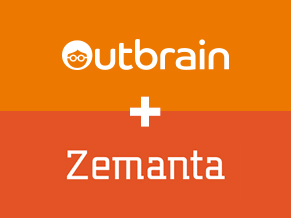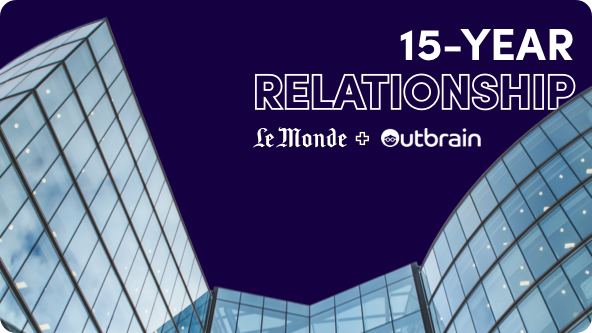A Conversation with Outbrain + Zemanta: Accelerating the Scale of Native Advertising

Today we announced our acquisition of Zemanta, the world’s leading dedicated native programmatic demand side platform (DSP). Zemanta is based in Ljubljana, Slovenia and has offices in New York and Seattle.
We’re excited about this opportunity to use the Zemanta technology for our Outbrain Programmatic Access service (OPA), to enable new budgets from programmatic partners and brands and agencies to flow into our network. We sat down with Gilad de Vries, SVP of Strategy at Outbrain and Todd Sawicki, CEO of Zemanta to learn more.
Q1: Why are you so excited about Outbrain + Zemanta coming together?
de Vries: This is an unparalleled opportunity to put native advertising on the same scale as a display. With Zemanta’s platform and Outbrain’s global footprint, we’ll be uniquely positioned to help marketers achieve true branding in digital. This means investing more in engaging with audiences natively with value-added content and investing less in interruptive experiences like banners and pre-rolls.
Sawicki: We are incredibly excited to have found a company that sees and believes what we fundamentally believe—how revolutionary native advertising will be to the web. Native advertising’s underlying technology allows for publishers to design unique advertising experiences—and for marketers to leverage those to engage with consumers in authentic and seamless ways. Now we can take advantage of Outbrain’s global scale to expand our platform across the globe so marketers everywhere can connect with consumers, in these truly non-interruptive and engaging ways. Brand marketing has always been about using storytelling to connect with consumers and native advertising is the best possible way to make that happen.
Q2. How have Zemanta and Outbrain been working together to date? How do you see this evolving with this acquisition?
de Vries: We have been working with the Zemanta team for years and were very impressed with their vision around what programmatic buying in the Content Marketing and Native Advertising space should look like. Their platform is unique in it’s ability to not only optimize to reach and frequency but also to be able to optimize for actual engagement and actions and conversions. Different marketers, agencies and media buyers have different strategies and goals they’re trying to achieve. We believe we’ll find many ways to help marketers scale their native advertising spend as we help grow the entire native ecosystem across the world.
Sawicki: When we started building our Native DSP, Outbrain was the first company we partnered with to connect programmatically. This is happening today because of our great working relationship—we truly like working together. There’s a great cultural fit. Outbrain is an international and diverse company with fantastic technical talent. Zemanta has pioneered the self-managed SaaS model for programmatic native. Our platform unlocks new channels and formats for agencies to run programmatic campaigns for their clients. No longer are they stuck just with plain, old display. This goes back to both companies’ belief in the potential of native to radically advance online advertising. Together, we can make that vision a reality so much faster than apart.
Q3: How do you think this acquisition will help your current and potential clients’ experience with your products?
de Vries: This is another important step in our announcement about opening up to programmatic demand from a couple of months ago. It’s about providing more flexibility for marketers, enabling them to choose between using their own data and tech stack or using our personalization algorithms and unique interest graph data set.
Sawicki: The Zemanta One Native DSP offers scale, control, transparency, ease of use, and unparalleled automation and optimization. Today, agencies and marketers expect to be able to control and see exactly where their media is running, at what price and in what ways. That’s where we come in—agencies can manage Outbrain and every other native SSP and exchange through our single dashboard, in one platform.
One of the coolest things about our platform is how easy it makes it for agencies and marketers to scale native campaigns through our Autopilot feature. Our Autopilot feature actually works like an airplane autopilot—it can handle campaign flight launches, optimizations, and landing mode all automatically. With integrations with Google and Adobe Analytics, we’re able to use that engagement data to automatically optimize campaigns run through our platform. Now with Outbrain, we’ll be able to scale that system to across the globe in ways we once assumed were years into the future.
Q4: Why do you think that Outbrain and Zemanta are such a good fit on a cultural level?
de Vries: We share the same lighthouse and strong desire to help people discover great content. Both companies share a very similar culture of innovation and focus on the user experience.
Sawicki: Zemanta has 26 people—20 of which are on the product and engineering side of the house. We are a product first organization. We have put our money where our mouth is by investing in great technology and innovation first and foremost. As we’ve learned from working side by side with Outbrain these past few years, the company is led by a great product visionary and a genuinely talented technology team. Both companies understand the value and importance of delivering great products to market. Combine that with the similar belief in how we can help people and marketers connect through content, and you have a winning combination. We are going to be able to take the lessons of scaling globally to our customers, and they are going to be able to take the power of programmatic native to their advertising customers.
Q5: Where do you see the ad tech industry moving? How do you think this acquisition fits in with how the industry is evolving?
de Vries: I believe that in a world where millennials are not willing to accept any form of interruption by marketers, the industry will have to shift to pulling audiences by providing real value adding messages and content through native experiences. Native is not just a new type of placement—it’s an opportunity actually engage with consumers, especially in mobile. It’s an opportunity for marketers to go beyond an “impression” or a “view” to actually tapping into people’s interest.
By leveraging machine learning and contextual signals, programmatic advertising can be tailored to both the user and the placement at scale, resulting in better performance for advertisers.
Sawicki: Programmatic native adoption by advertisers grew 86% by year’s end. And it is great because the real power and promise of native advertising are unlocked by programmatic. When marketers and agency hear that, they reflectively think of some of the early, handcrafted, native advertising experiences that publishers started with an offering. Those early native executions were about as un-programmatic and unscalable as you can possibly imagine.
But what’s driving programmatic native is the underlying technical standards, which allow publishers to craft amazing custom advertising experiences and formats. The end of the tyranny of IAB standard display ad sizes is at our fingertips. What prevented publishers from offering—and advertisers from taking advantage of unique user experiences—is that they didn’t scale. Often the publishers just didn’t reach enough users. But with programmatic native, creative is adapted on the fly to fit the publisher’s native experience. So even if that publisher only reaches one user, that ad impression can still be sold and trafficked because platforms like ours transform an advertiser’s content into that ad and ad format.














